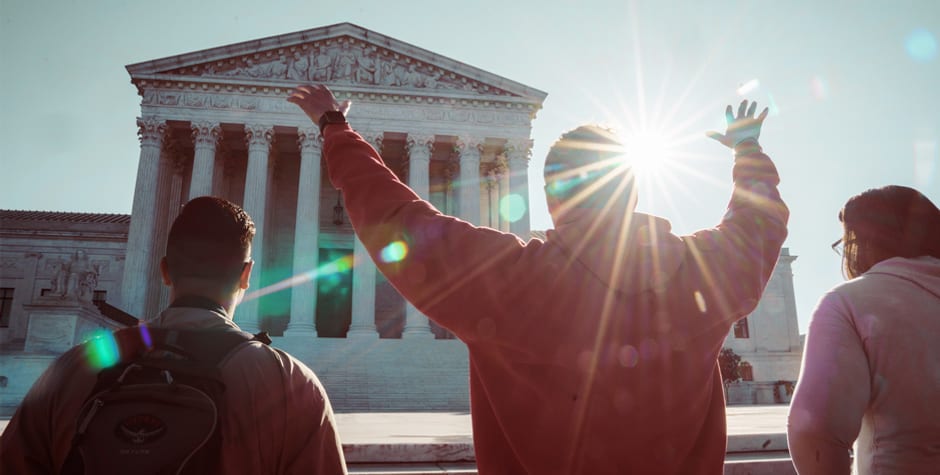ACLJ Responds at the Supreme Court to Atheist Attacks in Major Prayer Case
As previously discussed, the American Center for Law and Justice (ACLJ) has filed a petition for writ of certiorari asking the U.S. Supreme Court to hear a prayer case out of Florida that could lead to a landmark ruling on church-state lawsuits. The case, City of Ocala v. Rojas, attacks the so-called “offended observer” doctrine head-on.
To recap, there was a shooting spree in Ocala, Florida, in which children were injured. Community leaders proposed a prayer vigil in response, and the local chief of police, in keeping with a long history of public officials calling for prayer in response to crises, signed on to promote the community prayer vigil. Some local atheists objected, and a group of them attended the prayer vigil to “observe” what they expected to be, in their view, a violation of the “separation of church and state.” After the vigil, the American Humanist Association (AHA) and four atheists filed suit in federal district court, claiming a violation of the Establishment Clause and asserting the right to sue as “offended observers.” The ACLJ stepped in to defend the city.
After some back and forth and paring down of the case (e.g., the AHA was dismissed as a party, leaving just the individual plaintiffs represented by AHA counsel), the district court ruled against the city and the chief of police, awarding $1 to each of the atheist plaintiffs from both of the defendants. We took the case up on appeal. While our appeal was pending, the Supreme Court declared that the oft-criticized “Lemon” test – which the district court had used – was no longer to be employed in Establishment Clause cases. So the U.S. Court of Appeals for the Eleventh Circuit, after hearing our appeal in the Ocala case, vacated the district court ruling and sent the case back for reconsideration in a post-Lemon world.
That was a partial victory. However, the Eleventh Circuit squarely rejected our argument that the atheist plaintiffs did not have “standing” to sue in federal court. We had contended that the separationist plaintiffs did not allege any genuine, constitutionally cognizable “injury.” All they really alleged was personal upset over what they viewed as a constitutional violation. But disagreement, even over important issues, is not a ticket to federal court. Therefore, we contended, the whole suit should have been thrown out.
We decided to file a petition for certiorari with the Supreme Court, teeing up the question whether “offended observer” standing comports with the Constitution.
We filed our petition for Supreme Court review on September 22, 2022. The American Humanist Association filed a brief in opposition to our petition on November 28. That put the ball back in our court, so we filed a Reply to Brief in Opposition on December 13. We pointedly argued:
In their Brief in Opposition, respondents Lucinda Hale and Art Rojas provide no reason not to grant review. To the contrary, their brief further illustrates the need for this Court’s intervention.
We hammered the AHA’s argument that offense at what one saw was a permissible “symbolic injury.”
[The plaintiffs] seem not to grasp the difference between symbolic and actual harm. They assert that “the government . . . preventing someone from practicing religion can just as easily be cast as ‘mere offense’ or ‘hurt feelings,’” and that depriving someone of an item needed for a religious ritual causes “no harm other than a spiritual injury.” </p
In other words, the AHA’s position would dilute actual, concrete interference with religious practice by equating it with simply taking offense. Their brief also ignores the difference between being injured by a violation and merely witnessing a violation. As we explain:
[M]erely witnessing an alleged constitutional violation is not enough. The citizen who runs outside to view an arrest involving excessive force does not ipso facto have a claim against the police officer. The person who rushes across town to videotape the FBI swat team ransacking the wrong house does not have standing to bring a Fourth Amendment claim. That these hypothetical observers may be deeply shaken by what they saw, or passionately committed to righting the injustices they observed, does not translate into Article III standing. That they made a point personally to observe the violation underscores how plainly manipulable – and self-creating – offended observer standing in such cases would be.
The “offended observer” standing claim in this case, we note, is especially strange:
It would be madness to say, “I have no problem with inhaling tear gas; it was the fact that a government agent threw the device that’s the problem.” Yet that is essentially [plaintiffs’] position: they do not object to prayer vigils, just to those with excessive (in their view) government involvement. Their testimony . . . thus makes clear that their supposed injury is in reality ideological or constitutional disagreement, albeit dressed up in terms of personal offense.
You can read our whole reply brief (just 12 pages) here.
What comes next? The Supreme Court Justices are scheduled to consider our petition, the response, and our reply at their private conference on January 6, 2023. We need four of the nine Justices to vote to hear the case for the Court to grant review. We hope and pray that the Court agrees with us that “offended observer” standing is a bad idea that needs to be corrected.
